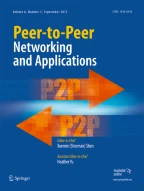Abstract
Fog computing has been recently proposed to move certain cloud computing services down to edge networks especially for mobile applications, aiming at improving the throughput and delay through the collaboration of mobile devices at edge wireless networks. Yet, the current edge wireless networks are the bottleneck that prohibits mobile devices to efficiently share their resources, due to the lack of an efficient mechanism of coordinating heterogeneous wireless networks (e.g., LTE, WiFi, and WiMax) to better utilize the radio resources. In this paper, we propose MiFo, a novel hierarchical dual-layer edge network integration framework for fog computing. At the lower level, the Mist layer manages the baseband resources of homogeneous networks in a centralized way, which can enhance the transmission performance through physical layer cooperation among base stations. At the upper level, the Fog layer coordinates the heterogeneous network access and the resource scheduling. In MiFo, we also propose a multi-stream concurrent (MSC) transmission protocol, which can make full use of diverse wireless network resources and significantly improve the data transmission rate of multi-mode mobile devices. The proposed MSC transmission protocol can also achieve smart handover and improve the energy efficiency as well.
Similar content being viewed by others
References
Jennings B, Stadler R (2015) Resource management in clouds: Survey and research challenges. J Netw Syst Manag 23(3):567–619
Simeone O, Maeder A, Peng M, Sahin O, Yu W (2016) Cloud radio access network: Virtualizing wireless access for dense heterogeneous systems. J Commun Netw 18(2):135–149
AlQerm I, Shihada B (2018) Sophisticated online learning scheme for green resource allocation in 5g heterogeneous cloud radio access networks. IEEE Trans Mob Comput
Bonomi F, Milito R, Zhu J, Addepalli S (2012) Fog computing and its role in the internet of things. In: Proceedings of the MCC workshop on mobile cloud computing
Yi S, Li C, Li Q (2015) A survey of fog computing: Concepts, applications and issues. In: Proceedings of the workshop on mobile big data (MoBiData). Hangzhou
Peng M, Yan S, Zhang K, Wang C (2016) Fog-computing-based radio access networks: Issues and challenges. IEEE Netw 30(4):46–53
Bi Y (2018) Neighboring vehicle-assisted fast handoff for vehicular fog communications. Peer-to-Peer Network Appl 11(4):738–748
Lu T, Chang S, Li W (2018) Fog computing enabling geographic routing for urban area vehicular network. Peer-to-Peer Network Appl 11(4):749–755
Shojafar M, Pooranian Z, Vinueza Naranjo PG, Baccarelli E (2017) Flaps: Bandwidth and delay-efficient distributed data searching in fog-supported p2p content delivery networks. J Supercomput 73(12):5239–5260
Santos J, Wauters T, Volckaert B, De Turck F (2018) Fog computing: Enabling the management and orchestration of smart city applications in 5g networks. Entropy, 20(1)
Bachmann K (2017) Design and implementation of a fog computing framework
Lei L, Zhong Z, Zheng K, Chen J, Meng H (2013) Challenges on wireless heterogeneous networks for mobile cloud computing. IEEE Wirel Commun 20(3):34–44
Feng M, Jiang T, Chen D, Mao S (2014) Cooperative small cell networks: High capacity for hotspots with interference mitigation. IEEE Wirel Commun 21(6):108–116
Zhang N, Cheng N, Gamage AT, Zhang K (2015) Cloud assisted hetnets toward 5g wireless networks. IEEE Commun Mag 53(6):59–65
Hu F, Hao Q, Bao K (2014) A survey on software-defined network and openflow: From concept to implementation. IEEE Commun Surv Tutor 16(4):2181–2206
Hawilo H, Shami A, Mirahmadi M, Asal R (2014) Nfv: State of the art, challenges and implementation in next generation mobile networks (vepc). IEEE Netw 28(6):18–26
3GPP TS 23.234 V13.1.0 (2017) 3gpp system to wireless local area network (wlan) interworking system description (release 13), March 2017
Peng M, Wang C, Li J, Xiang H, Lau V (2015) Recent advances in underlay heterogeneous networks: Interference control, resource allocation, and self-organization. IEEE Commun Surv Tutor 17(2):700–729
Cui Q, Shi Y, Tao X, Zhang P, Liu R, Chen N, Hamalainen J, Dowhuszko A (2014) A unified protocol stack solution for lte and wlan in future mobile converged networks. IEEE Wirel Commun 21(6):24–33
Han H, Shakkottai S, Hollot CV, Srikant R, Towsley D (2006) Multi-path tcp: A joint congestion control and routing scheme to exploit path diversity in the internet. IEEE/ACM Trans Network 14(6):1260–1271
Yin Z, Yu FR, Bu S, Han Z (2015) Joint cloud and wireless networks operations in mobile cloud computing environments with telecom operator cloud. IEEE Trans Wirel Commun 14(7):4020–4033
Yang B, Wang D, Sun J, Liu Y (2013) On the degrees of freedom region of general mimo broadcast channel with mixed csit. In: Proceedings of IEEE International symposium on information theory (ISIT)
Zhu Y, Wang L, Wong K-K, Jin S, Zheng Z (2016) Wireless power transfer in massive mimo aided hetnets with user association. IEEE Trans Commun 64(10):4181–4195
Gesbert D, Hanly S, Huang H, Shamai Shitz S, Simeone O, Yu W (2010) Multi-cell mimo cooperative networks: A new look at interference. IEEE J Select Areas Commun 28(9):1380–1408
Soret B, Wang H, Pedersen KI, Rosa C (2013) Multicell cooperation for lte-advanced heterogeneous network scenarios. IEEE Wirel Commun 20(1):27–34
Wang S, Sun Y (2017) Enhancing performance of heterogeneous cloud radio access networks with efficient user association. In: Proceedings of IEEE international conference on communications (ICC)
Funding
This work was supported in part by the National Natural Science Foundation of China under Grant 61702204, Grant 61502192, and Grant 61502193, and in part by the Fundamental Research Funds for the Central Universities under Grant 2016YXMS293.
Author information
Authors and Affiliations
Corresponding author
Rights and permissions
About this article
Cite this article
Wang, D., Ding, W., Ma, X. et al. MiFo: A novel edge network integration framework for fog computing. Peer-to-Peer Netw. Appl. 12, 269–279 (2019). https://doi.org/10.1007/s12083-018-0663-z
Received:
Accepted:
Published:
Issue Date:
DOI: https://doi.org/10.1007/s12083-018-0663-z
